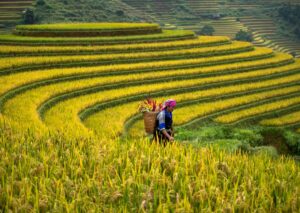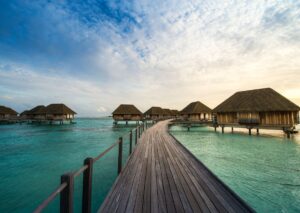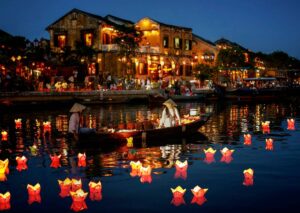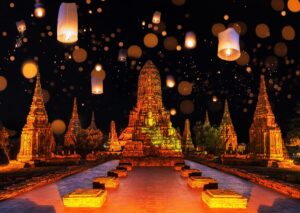Hey there, adventure seekers and mountain enthusiasts! Frank here, your friendly neighborhood travel blogger and self-proclaimed Himalayan aficionado. Today, we’re diving headfirst into the heart-pounding, jaw-dropping, and sometimes knee-wobbling world of the Annapurna Base Camp Trek (ABC Trek for short). Buckle up, buttercup, because this isn’t your grandma’s nature walk – unless, of course, your grandma is a hardcore mountaineer. In that case, high five to Granny!
Picture this: You’re standing at the foot of some of the world’s most majestic peaks, surrounded by a panorama so breathtaking it makes the default Windows wallpaper look like a kid’s crayon drawing. The crisp mountain air fills your lungs, carrying with it the scent of adventure and maybe a hint of yak. You’ve just conquered thousands of steps and crossed swaying bridges that would make Indiana Jones think twice, and now you’re here – the legendary Annapurna Base Camp.
But hold your horses (or should I say, hold your yaks?), we’re getting ahead of ourselves. Before you start packing your selfie stick and energy bars, let’s take a deep dive into what makes the ABC Trek the crown jewel of Nepal’s trekking scene. From the lush rhododendron forests that’ll make you feel like you’re in a botanical fairy tale, to the charming teahouses where you’ll gulp down more dal bhat than you thought humanly possible, we’re covering it all.
So, whether you’re a seasoned trekker with calves of steel or a newbie whose idea of hiking is taking the stairs instead of the elevator, this guide is your golden ticket to conquering the ABC Trek. We’ll laugh, we’ll cry (mostly from the altitude), and by the end, you’ll be ready to embark on the adventure of a lifetime. Let’s lace up those boots and hit the trail!
Annapurna Base Camp: Where the Mountains Meet Mirth
Welcome to the Annapurna Conservation Area, home to the ABC Trek and quite possibly the world’s most impressive natural amphitheater. Nestled in the heart of Nepal, this trekking route is like the Goldilocks of Himalayan adventures – not too easy, not too hard, but just right for those seeking a challenge without needing to be a superhuman mountaineer.

Quick Facts:
- Location: Annapurna Region, Nepal
- Language: Nepali (but “Namaste” and a smile go a long way)
- Currency: Nepalese Rupee (NPR)
- Time Zone: Nepal Time (NPT), UTC+5:45 (Yes, that :45 is correct – Nepal likes to keep things interesting)
What makes the ABC Trek unique? Oh, let me count the ways! First off, where else can you go from tropical forests to snow-capped peaks in just a few days? It’s like Mother Nature decided to showcase all her best work in one compact area. Then there’s the cultural smorgasbord – from traditional Gurung villages to the warm hospitality of the mountain teahouses, it’s a trek for both the body and the soul.

But the real showstopper? The mountains themselves. We’re talking about rubbing elbows (metaphorically, of course) with giants like Annapurna I (8,091m), Machapuchare (6,993m) – aka the “Fishtail” mountain that looks like nature’s own Toblerone – and a whole cast of supporting peaks that would make any mountain range jealous.
How to Get There: The Journey Begins
Alright, future trekkers, let’s talk about how to get your boots on Nepalese soil. Your gateway to the Annapurna region is the charming city of Pokhara, but first, you’ve got to get to Nepal.
Flying to Nepal
Most international flights will land at Tribhuvan International Airport in Kathmandu. From there, you have two options to reach Pokhara:

- Domestic Flight: A quick 25-minute flight from Kathmandu to Pokhara. It’s fast, it’s scenic, and it’s a great way to get a bird’s eye view of the terrain you’ll soon be conquering on foot. Book your flights through CheapOair for the best deals.
- Bus or Private Transfer: For the more adventurous (or budget-conscious), a 6-7 hour bus ride from Kathmandu to Pokhara offers a ground-level view of Nepal’s countryside. It’s longer, but hey, it’s all part of the adventure, right?
Pro Tip: If you’re prone to motion sickness, the winding roads might make you wish you’d taken the plane. Pack some dramamine!
From Pokhara to the Trailhead
Once in Pokhara, you’re just a jeep ride away from the start of your trek. Most trekkers begin their journey from Nayapul or Phedi, both a couple of hours’ drive from Pokhara.

Getting Around Pokhara:
- Taxis are plentiful and relatively cheap
- For the eco-conscious, bicycle rentals are available
- Walking is always an option – it’s good practice for the trek ahead!
Daily Budget: Counting Your Rupees
Now, let’s talk money, honey. Trekking in Nepal is relatively affordable compared to many other adventure destinations, but it’s good to know what you’re in for.
Estimated Daily Budget: 2000-3000 NPR ($15-25 USD) per day on the trek
This includes:
- Teahouse accommodation: 500-1000 NPR per night
- Meals: 500-800 NPR per meal
- Permits and fees: TIMS Card (2000 NPR) and Annapurna Conservation Area Permit (3000 NPR)
Pro Tip: Prices tend to increase with altitude, so budget a bit more for the higher reaches of the trek.
Remember, this is just for the trek itself. Factor in additional costs for your time in Kathmandu and Pokhara, as well as any gear you might need to rent or buy.
Where to Stay: From Pokhara to the Peaks
Your ABC Trek adventure is bookended by stays in Pokhara, so let’s start there before we head up to the mountain teahouses.
Pokhara: Your Launchpad to the Annapurnas
Budget-Friendly:


- Pokhara Backpackers Hostel: Perfect for solo travelers looking to meet fellow trekkers. Dorm beds start at around $5 USD per night.
- Hotel Crown Himalayas: Clean, comfortable, and centrally located. Private rooms from $15 USD.
Mid-Range:


- Hotel Barahi: Lovely garden setting and a pool to soak those post-trek muscles. Rooms from $50 USD.
- Atithi Resort & Spa: Great amenities and mountain views. Rooms from $60 USD.
Luxury:


- Temple Tree Resort & Spa: Serene setting with top-notch facilities. Rooms from $100 USD.
- Pavilions Himalayas: For those who want to splurge. Villas from $250 USD.
Book your Pokhara stay through Booking.com for the best rates and flexibility.
On the Trek: Teahouse Accommodations
Once you hit the trail, you’ll be staying in teahouses. These are simple lodges run by local families, offering basic but comfortable accommodation.

What to Expect in Teahouses:
- Basic rooms with twin beds
- Shared bathrooms (usually)
- Common dining areas where you’ll eat and socialize
- Limited electricity and occasional Wi-Fi (for a fee)
Pro Tip: Bring a sleeping bag! While most teahouses provide blankets, your own sleeping bag ensures warmth and hygiene.
Top Things to Do: Beyond Just Trekking
Sure, the main event is the trek itself, but there’s so much more to experience along the way!
Must-Visit Landmarks and Attractions

- Poon Hill: Often added as a side trip, this viewpoint offers stunning sunrise views over the Annapurna range.
- Machapuchare Base Camp: The closest you can get to the sacred Fishtail Mountain.
- Annapurna Base Camp: The grand finale, surrounded by a 360-degree panorama of Himalayan giants.
Hidden Gems
- Hot Springs at Jhinu Danda: Soothe your aching muscles in these natural hot springs.
- Chomrong Village: Try the famous Gurung bread and apple pie.
- Bamboo Forest Trek: Between Sinuwa and Bamboo, trek through magical bamboo forests.
Cultural Activities

- Visit a Local Monastery: Many villages have small Buddhist monasteries you can visit.
- Participate in a Puja Ceremony: If you’re lucky, you might witness or even be invited to join a traditional blessing ceremony.
Outdoor Adventures

- Sunrise at Annapurna Base Camp: Worth the early wake-up call, trust me!
- River Crossings: Test your balance on suspension bridges over rushing glacial rivers.
- Wildlife Spotting: Keep your eyes peeled for Himalayan tahr, musk deer, and if you’re incredibly lucky, the elusive snow leopard.
Book guided tours and activities through GetYourGuide for expert local insights and seamless experiences.
Food and Drink Guide: Fueling Your Trek
Alright, foodies and culinary adventurers, let’s talk about the fuel that’ll power you up those mountains. Nepali cuisine is a delightful mix of flavors, and the food on the ABC Trek is no exception. Just remember, as you climb higher, the menu might get simpler – but trust me, after a day of trekking, even a simple dal bhat will taste like a Michelin-starred meal.
Must-Try Local Dishes



- Dal Bhat: The ultimate trekker’s fuel. This combo of lentil soup, rice, and vegetable curry is often served as an all-you-can-eat meal. Pro tip: Eat like a local and use your right hand!
- Momos: These Nepali dumplings come in veg and non-veg varieties. Perfect for a quick snack or a hearty meal.
- Sherpa Stew: A hearty soup packed with vegetables, meat (optional), and noodles. It’s like a warm hug for your insides.
- Gurung Bread: A fried bread that’s crispy on the outside, and soft on the inside. Often served with honey or jam.
- Tibetan Bread: Similar to a flatbread, it’s great for breakfast with eggs or as a snack with tea.
Drinks to Keep You Hydrated (and Happy)


- Masala Chai: Spiced tea that’ll warm you up on chilly mornings.
- Hot Lemon: Simple, refreshing, and great for preventing altitude sickness.
- Seabuckthorn Juice: A local superfruit juice packed with vitamins.
- Raksi: A local rice wine. Enjoy responsibly, as alcohol can worsen altitude sickness.
Where to Find the Best Eats
- Chomrong Cottage: Famous for its chocolate cake. Yes, chocolate cake at 2170m!
- Himalaya Guest House in Deurali: Known for its hearty portions and friendly service.
- Paradise Guest House at ABC: The highest restaurant on the trek, with surprisingly good pizza.
Vegetarian and Vegan Options
Good news for plant-based trekkers! Most teahouses offer plenty of vegetarian options, and many can accommodate vegan diets too. Just be clear about your dietary needs.
Pro Tip: As you ascend, meat becomes less fresh and more expensive. Many experienced trekkers stick to vegetarian options higher up.
Eco-Conscious Eating
- Carry a reusable water bottle and use safe water refill stations along the trek.
- Opt for locally sourced foods to reduce your carbon footprint.
- Consider bringing your own reusable cutlery set to minimize plastic waste.
Remember, staying well-fed and hydrated is crucial for a successful trek. Don’t skimp on meals, and always listen to your body. And hey, you’re burning thousands of calories a day – if there’s ever a time to indulge guilt-free in that extra slice of apple pie, this is it!
Best Time to Visit: Timing Your Trek to Perfection
Choosing when to tackle the ABC Trek is like picking the perfect avocado – timing is everything! Let’s break it down by seasons so you can plan your adventure when it suits you best.

Spring (March to May)
Pros:
- Rhododendron forests in full bloom (Instagram, get ready!)
- Clear mornings with stunning mountain views
- Comfortable temperatures for trekking
Cons:
- Can get busy, especially in April and May
- Afternoon clouds might obscure views
Verdict: Ideal for flower enthusiasts and those who prefer milder temperatures.
Summer/Monsoon (June to August)
Pros:
- Lush, green landscapes
- Fewer crowds
- Lower prices
Cons:
- Rain, rain, and more rain
- Leeches become your new trekking buddies
- Higher risk of flight delays or cancellations
Verdict: For the adventurous and budget-conscious, but be prepared for wet conditions.
Autumn (September to November)
Pros:
- Clear skies and excellent visibility
- Comfortable temperatures
- Festive atmosphere with Nepali holidays
Cons:
- Peak season means crowded trails and teahouses
- Higher prices
Verdict: The most popular time for good reason – perfect weather and views.
Winter (December to February)
Pros:
- Crisp, clear days with breathtaking mountain views
- Fewer crowds
- Chance of snow (for those dreaming of a white trek)
Cons:
- Cold temperatures, especially at night
- Some higher teahouses might be closed
- Increased risk of weather-related trail closures
Verdict: Great for those who don’t mind the cold and want solitude.
Pro Tip: Book your trek through Trip.com for seasonal deals and flexible booking options.
Packing Tips: What to Bring (And What to Leave Behind)
Alright, let’s talk about the art of packing for the ABC Trek. Remember, you’ll be carrying everything on your back (or your porter’s back – more on that later), so every gram counts!

Essential Gear
- Sturdy Hiking Boots: Break them in before the trek to avoid blisters.
- Sleeping Bag: Rated for at least -10°C (14°F).
- Trekking Poles: Your knees will thank you.
- Water Purification System: Either tablets or a filter bottle.
- Headlamp: For those early morning starts and late-night bathroom trips.
Clothing
- Base Layers: Moisture-wicking and quick-drying.
- Insulating Layers: Fleece or down jacket.
- Waterproof Outer Layer: Both jacket and pants.
- Hiking Socks: Bring several pairs.
- Warm Hat and Gloves
- Sun Hat
Miscellaneous
- Sunscreen and Lip Balm: The sun is intense at altitude.
- First Aid Kit: Including any personal medications.
- Camera: Trust me, you’ll want to capture these views.
- Power Bank: Charging options are limited on the trail.
Eco-Friendly Gear Suggestions
- Reusable Water Bottle: Reduce plastic waste on the trail.
- Solar Charger: Harness the power of the sun for your devices.
- Biodegradable Soap and Shampoo: Keep those mountain streams clean.
Pro Tip: Many items can be rented in Pokhara if you don’t want to invest in or carry specialized gear.
Is It Safe?: Staying Secure in the Himalayas

Safety first, fun second – that’s the mountaineer’s motto (okay, I just made that up, but it sounds good, right?). The ABC Trek is generally considered safe, but there are always risks when you’re in remote mountain areas.
General Safety Tips
- Acclimatize Properly: Take rest days and don’t ascend too quickly to avoid altitude sickness.
- Stay Hydrated: Drink plenty of water and avoid alcohol, especially at higher altitudes.
- Trek with a Buddy: Solo trekking can be risky. Consider joining a group or hiring a guide.
- Stay on Marked Trails: Wandering off can lead to accidents or getting lost.
- Check Weather Forecasts: Mountain weather can change rapidly.
Common Risks and How to Avoid Them

- Altitude Sickness:
- Symptoms: Headache, nausea, dizziness
- Prevention: Ascend slowly, stay hydrated, consider taking Diamox (consult your doctor)
2. Hypothermia:
- Risk: Especially in winter or during unexpected weather changes
- Prevention: Layer your clothing, stay dry, and be prepared for cold nights
3. Stomach Issues:
- Risk: From contaminated water or food
- Prevention: Use water purification methods, eat cooked foods, and practice good hygiene
Emergency Contacts
- Nepal Tourism Board: +977 1 4256909
- Himalayan Rescue Association: +977 1 4440292/4440293

Pro Tip: Consider getting travel insurance that covers high-altitude trekking. Check out EKTA Travel Insurance for comprehensive coverage tailored for adventure travelers.
Budget-Friendly Tips: Trekking Without Breaking the Bank
Who says you need to empty your wallet to conquer the Annapurnas? Here are some tips to keep your budget as high as the peaks you’ll be climbing:
- Travel in the Off-Season: Prices for accommodation and guides are lower during the less popular months.
- Eat Local: Stick to dal bhat and other local dishes. They’re not only cheaper but also provide the best energy for trekking.
- Carry Your Own Gear: Hiring a porter adds to the cost. If you’re fit enough, carry your own backpack.
- Use a Water Purification System: Buying bottled water adds up quickly and creates plastic waste.
- Share Rooms: Most teahouses offer shared accommodations at a lower cost.
- Negotiate Prices: Especially in the off-season, you might be able to bargain for better rates at teahouses.
- Book Direct: While using a trekking agency can be convenient, organizing the trek yourself can save money.
Pro Tip: Use Wise for international money transfers to get the best exchange rates and avoid hefty bank fees.
How Long to Stay: Crafting Your Perfect Itinerary
The ABC Trek is typically done in 7-12 days, depending on your pace and whether you include side trips. Here’s a sample itinerary to give you an idea:

7-Day Express Itinerary (for the time-crunched trekker)
- Nayapul to Ghandruk
- Ghandruk to Chhomrong
- Chhomrong to Deurali
- Deurali to Annapurna Base Camp
- Annapurna Base Camp to Bamboo
- Bamboo to Jhinu Danda (hot springs!)
- Jhinu Danda to Nayapul, drive to Pokhara
10-12 Day Leisurely Itinerary (for those who like to stop and smell the rhododendrons)
- Nayapul to Tikhedhunga
- Tikhedhunga to Ghorepani
- Ghorepani to Poon Hill for sunrise, then to Tadapani
- Tadapani to Chhomrong
- Chhomrong to Bamboo
- Bamboo to Deurali
- Deurali to Machhapuchhre Base Camp
- Machhapuchhre Base Camp to Annapurna Base Camp
- Annapurna Base Camp (rest day and exploration)
- Annapurna Base Camp to Bamboo
- Bamboo to Jhinu Danda (hot springs!)
- Jhinu Danda to Nayapul, drive to Pokhara
Pro Tip: Book your accommodations along the trek through Booking.com to ensure you have a place to rest your weary head each night.
Best Sunrise/Sunset Spots: Nature’s Light Show
Get your cameras ready, folks! Here are the spots where Mother Nature puts on her best performances:

- Poon Hill: The classic sunrise spot. 360-degree views of the Annapurna and Dhaulagiri ranges.
- Annapurna Base Camp: Watching the alpenglow on the surrounding peaks is like seeing the mountains blush.
- High Camp: Fewer crowds than ABC, but equally stunning views.
- Machapuchare Base Camp: The Fishtail Mountain puts on a show at both sunrise and sunset.
- Ghandruk: Lower altitude, but offers a different perspective with terraced fields in the foreground.
Pro Tip: Bring a lightweight tripod for those perfect low-light shots. Your Instagram followers will thank you!
City Map: Navigating Your Adventure
While a detailed trail map is best obtained in Pokhara or from your guide, here’s a general overview of the ABC Trek route:

Key Points to Note:
- Nayapul: Common starting point
- Ghorepani: Gateway to Poon Hill
- Chhomrong: Last permanent settlement before ABC
- Machapuchare Base Camp: Last stop before ABC
- Annapurna Base Camp: The grand finale!
Sustainable Travel Tips: Trekking with a Conscience
Let’s keep these mountains pristine for future generations of trekkers, shall we?
- Follow the “Leave No Trace” Principles: Pack out all your trash, including biodegradable items.
- Use Refillable Water Bottles: Many teahouses offer safe drinking water refills.
- Respect Local Customs: Ask before taking photos of people or entering religious sites.
- Support Local Businesses: Buy locally made souvenirs and use local guides.
- Stick to Established Trails: To prevent erosion and protect fragile ecosystems.
- Use Biodegradable Products: From soap to toilet paper, choose eco-friendly options.
- Minimize Fire Impact: Many areas have restrictions on campfires to protect forests.
Pro Tip: Consider offsetting your carbon footprint from your flights to Nepal through reputable carbon offset programs.
Final Tips for Visitors: The Cherry on Top of Your Trek
- Learn Basic Nepali Phrases: A little effort goes a long way in connecting with locals.
- Get a Local SIM Card: Available in Kathmandu or Pokhara. Check out Yesim eSIM for hassle-free connectivity.
- Carry Cash: ATMs are non-existent on the trail. Bring enough Nepalese Rupees for your entire trek.
- Respect Prayer Flags and Stupas: Always pass them on your left, moving clockwise.
- Be Flexible: Weather and unforeseen circumstances might alter your plans. Go with the flow!
- Bring Entertainment: Cards, books, or downloaded podcasts for those long evenings in teahouses.
- Document Your Journey: Keep a travel journal. You’ll treasure those memories later.
Your Annapurna Adventure Awaits!

Whew! We’ve covered a lot of ground, haven’t we? From the practicalities of packing to the magic of mountain sunrises, you’re now armed with all the info you need to tackle the ABC Trek. Remember, this journey is as much about the stunning vistas as it is about the people you’ll meet, the challenges you’ll overcome, and the personal growth you’ll experience.
As you stand at Annapurna Base Camp, surrounded by some of the world’s highest peaks, take a moment to soak it all in. You’ve just completed one of the most beautiful treks on the planet. Pat yourself on the back (or better yet, treat yourself to that second slice of apple pie when you get back to Pokhara).
Now, it’s your turn to hit the trail and create your own Annapurna story. And when you do, I want to hear all about it! Drop a comment below, share your favorite photos, or tell us about that time you almost got photobombed by a yak. Your experiences and tips will help future trekkers embark on their own adventures.
Don’t forget to subscribe to the blog for more trekking tales, travel tips, and adventure inspiration. Follow me on Instagram @a.tinytraveler for behind-the-scenes looks at my latest escapades. And if you found this guide helpful, why not share it with your fellow adventure-seekers?
Remember, the mountains are calling, and you must go. Happy trekking, and namaste!







